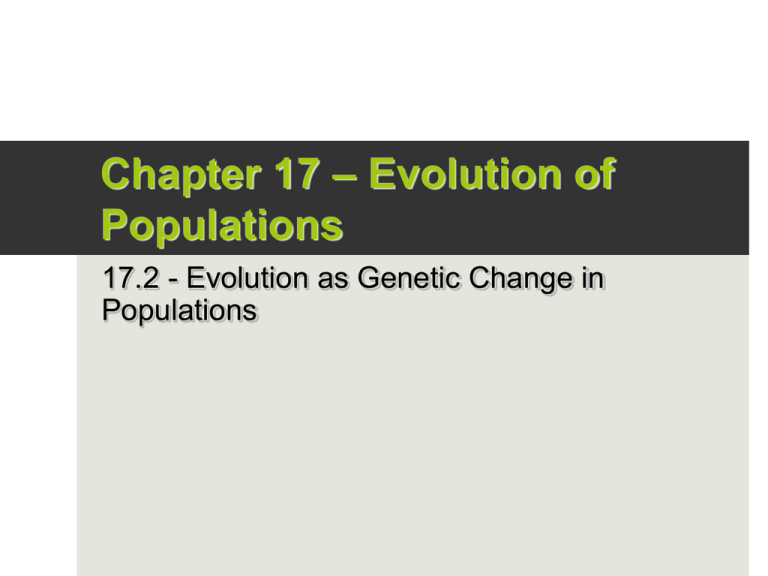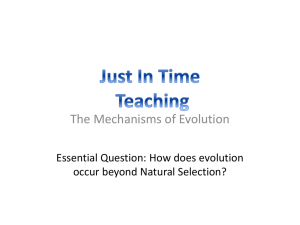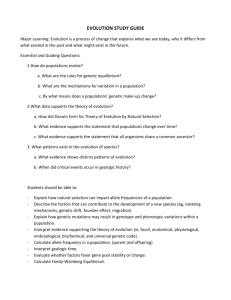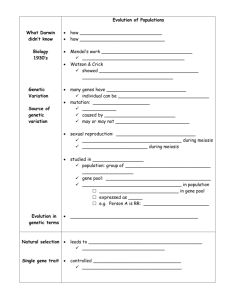17.2 – Evolution as Genetic Change in Populations
advertisement

17.2 – Evolution as Genetic Change in Populations Chapter 17 – Evolution of Populations 17.2 - Evolution as Genetic Change in Populations 17.2 – Evolution as Genetic Change in Populations How Natural Selection Works – Review In genetic terms, what does fitness mean? -Passing on genes onto offspring Adaptation: Any genetically controlled trait that increases an individual’s ability to pass along its alleles. 17.2 – Evolution as Genetic Change in Populations Natural Selection on Single-Gene Traits • Natural selection on a single-gene trait can lead to changes in allele frequencies and thus to differences in phenotype frequency. 17.2 – Evolution as Genetic Change in Populations Natural Selection on Polygenic Traits • Polygenic traits have a range of phenotypes that often form a bell curve. • The fitness of individuals may vary from one end of the curve to the other. • Natural selection can affect the relative fitness of a phenotype and result in one of three types of selection. • Direction Selection • Stabilizing Selection • Disruptive Selection 17.2 – Evolution as Genetic Change in Populations Directional Selection • When individuals at one end of the curve have higher fitness than individuals in the middle or at the other end. • The range of phenotypes shifts. 17.2 – Evolution as Genetic Change in Populations Stabilizing Selection • Individuals near the center of the curve have higher fitness than individuals at either end. • Center of the curve at its current position, narrows the overall graph. 17.2 – Evolution as Genetic Change in Populations Disruptive Selection • When individuals at the upper and lower ends of the curve have higher fitness than individuals near the middle. • Acts against individuals of an intermediate type • Can create 2 distinct phenotypes 17.2 – Evolution as Genetic Change in Populations Changes in Gene Pools Due to Chance • Genetic Drift: a change in the gene pool (allele frequency) of a population due to chance. • Over time, a series of chance occurrences can cause an allele to become more or less common in a population. 17.2 – Evolution as Genetic Change in Populations Examples of Genetic Drift • Bottleneck Effect - Chance decreases the size and genetic variation of the population, decreases adaptability • Ex. - when a population is reduced in size (due to a disaster) and ultimately the gene pool of the population is also reduced in size 17.2 – Evolution as Genetic Change in Populations Examples of Genetic Drift •Founder Effect - when few individuals colonize an isolated environment, reducing the gene pool of the population •Chance decreases genetic variation •Change in the gene pool is determined by the founders of the colony 17.2 – Evolution as Genetic Change in Populations Other Mechanisms of Gene Pool Changes • Gene Flow - the exchange of genes with another population • Occurs when fertile individuals or their gametes migrate between populations (ex: wind and pollen) • Tends to reduce genetic differences between populations 17.2 – Evolution as Genetic Change in Populations Natural Selection and Fitness • Only natural selection leads to adaptation • Genetic Drift, Gene Flow, and Mutations do not necessarily lead to adaptation • These do not tend to increase fitness within a population UseGenetic the choices on the right to 17.2 – Warm-up: Evolution as Change in Populations describe the scenarios on the left Scenario 1: 4 moose were taken from the Canadian mainland to Newfoundland, in 1904. These 2 males and 2 females rapidly formed a large population of moose that now flourishes in Newfoundland. Scenario 2: The fossil remains of pygmy (or dwarf) mammoths (1.5 m to 2 m tall) have been found on Santa Rosa and San Miguel Islands off the coast of California. This population of pygmy mammoths is descended from a population of mammoths of normal size (4 m tall). Dwarfing is common in island populations and is not the result of chance events. Scenario 3: Bearded Vultures in the Alps was nearly hunted to extinction. The population is currently small and lacks genetic variation. Which mechanism is most likely to have contributed to the 3 scenarios to the left? A. Bottleneck Effect B. Founder effect C. Natural Selection 17.2 – Evolution as Genetic Change in Populations Evolution VS Genetic Equilibrium • If a population is not evolving, allele frequencies in its gene pool do NOT change this is genetic equilibrium • Sexual reproduction and allele frequency: A population of sexually reproducing organisms could remain in genetic equilibrium (random mating) 17.2 – Evolution as Genetic Change in Populations Hardy-Weinberg Principle • Hardy-Weinberg principle - states that allele frequencies in a population should remain constant unless one or more factors cause those frequencies to change. • 5 conditions that disturb genetic equilibrium and cause evolution to occur: 17.2 – Evolution as Genetic Change in Populations 5 Conditions that Disturb Genetic Equilibrium 1. Nonrandom mating a. Sexual selection: When individuals of a species select mates based on heritable traits (size, strength, color, etc) 2. Small population size (Genetic drift happens easily) 3. Immigration/Emigration (Introduction of new alleles to a gene pool, or removing alleles from a gene pool) 4. Natural Selection (If different genotypes have different fitness, evolution will occur) 5. Mutation









